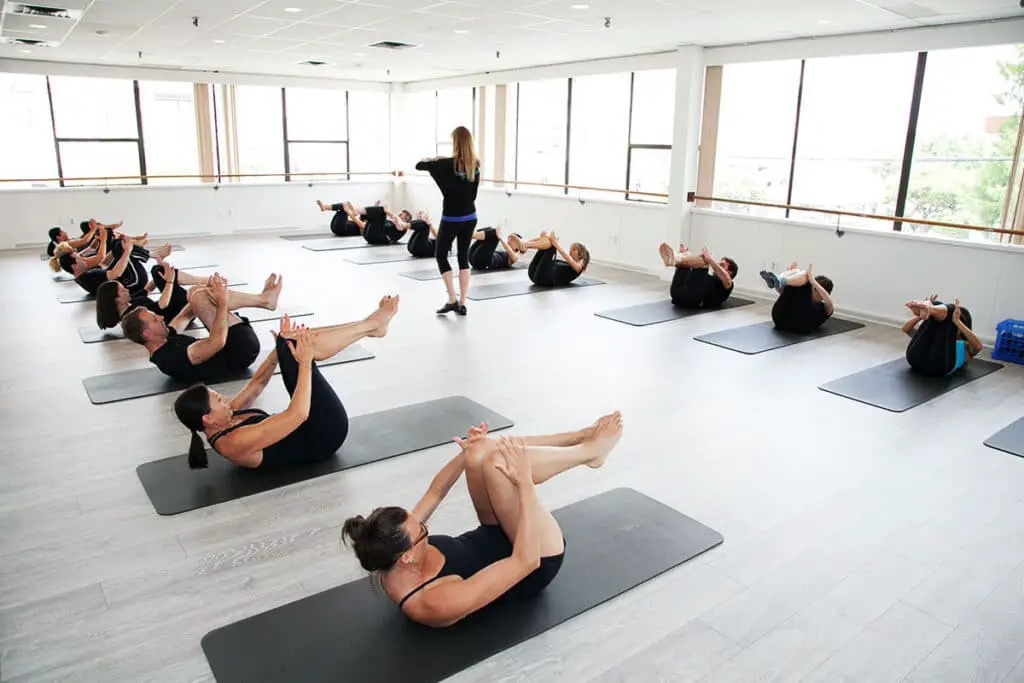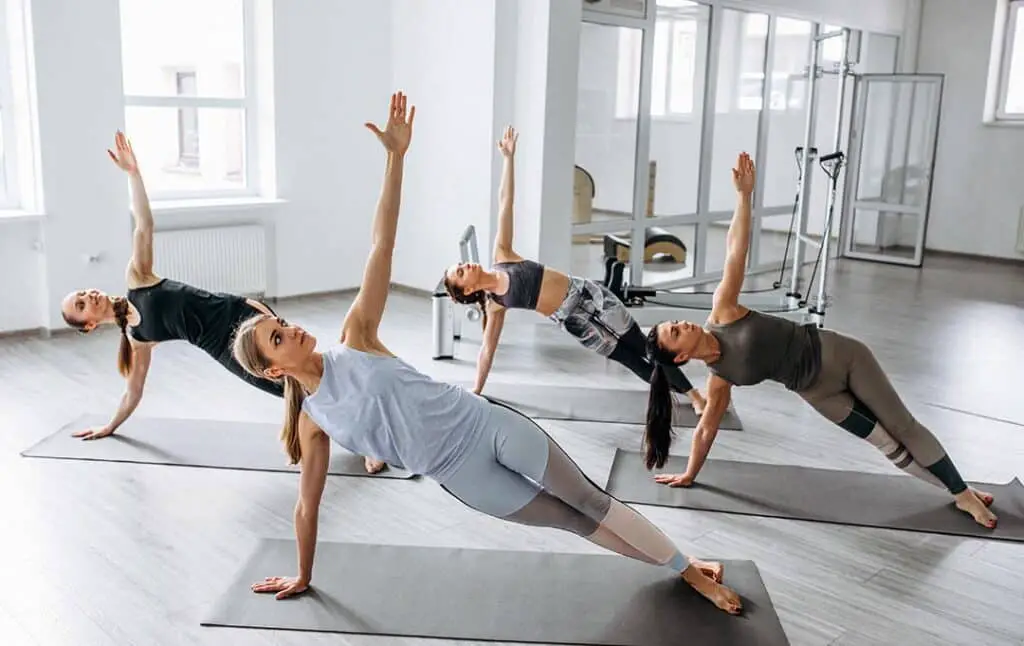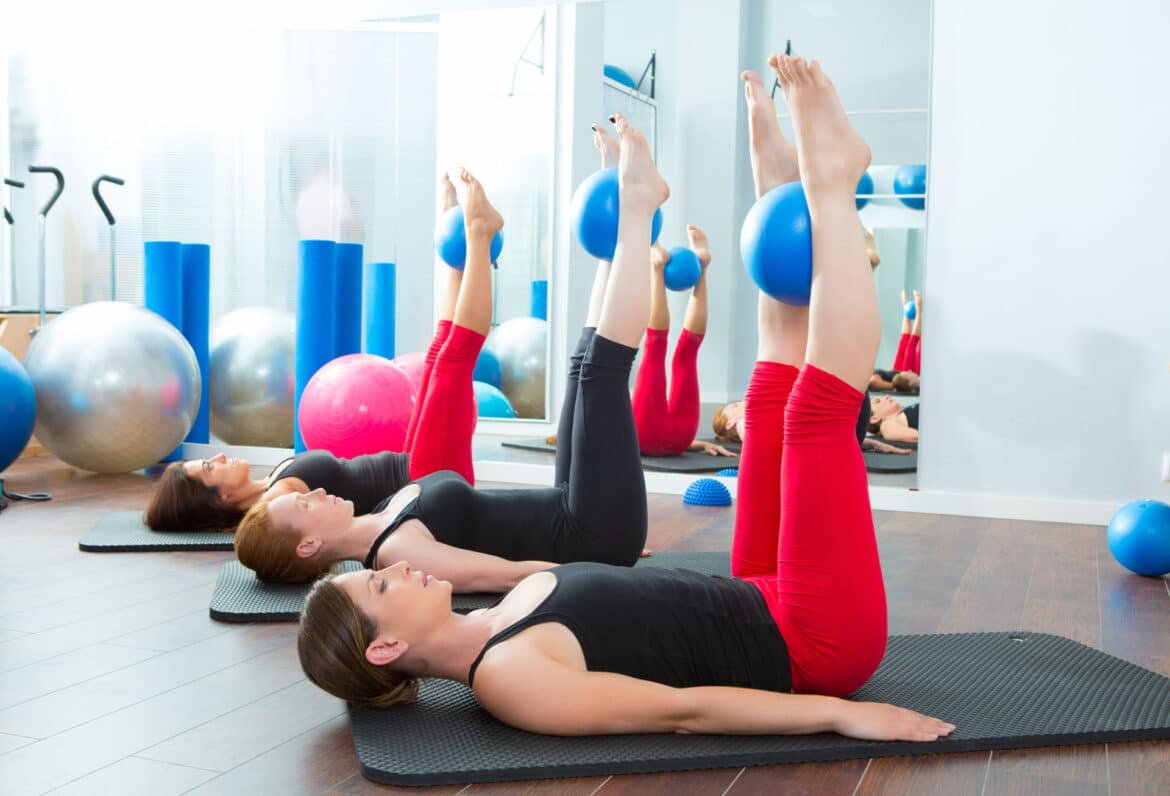Introduction
What Is Mat Pilates: Mat Pilates is a popular and highly effective form of exercise that focuses on strengthening the body’s core muscles, improving flexibility, and enhancing overall body awareness. Developed by Joseph Pilates in the early 20th century, this fitness method has gained widespread recognition and is practiced by individuals of all fitness levels and backgrounds. Unlike traditional Pilates, which often involves the use of specialized equipment, Mat Pilates primarily relies on a series of floor-based exercises that use the body’s own resistance for resistance and support. In this introduction, we will explore the fundamental principles and benefits of Mat Pilates, shedding light on how it can be a transformative and accessible practice for achieving physical and mental well-being.
Whether you’re a beginner looking to enhance your fitness routine or an experienced practitioner seeking to deepen your understanding, Mat Pilates offers a holistic approach to improving your strength, flexibility, and posture while promoting a sense of harmony between mind and body. Mat Pilates places a strong emphasis on strengthening the core muscles, including the abdominals, lower back, hips, and buttocks. This core engagement is fundamental to all Mat Pilates work exercises and is essential for maintaining stability and proper alignment throughout the movements. One of the distinctive aspects of Mat Pilates is the emphasis on mindfulness and body awareness.
Practitioners are encouraged to focus on their breath, proper alignment, and precise movements. This mindfulness helps improve coordination and concentration while reducing stress. Unlike some other forms of Pilates, Mat Pilates doesn’t require specialized equipment. It is typically performed on a mat or soft surface, making it accessible and cost-effective. However, small props like resistance bands, stability balls, and foam rollers may be incorporated to add variety and challenge to workouts.

What is Mat Pilates good for?
Benefits of Matwork Pilates
This targeted strengthening and stretching exercises help ease tight muscles, improve flexibility, and reduce tension throughout the body. Full Body Toning – Mat Pilates is well-known as a powerful way to fire up your core, but it also targets the entire body.
What is Mat Pilates
Mat Pilates is a series of exercises that are typically performed on a specialized, cushioned mat. These exercises emphasize controlled movements, precise form, and the engagement of core muscles. Unlike Pilates machines, which use springs and pulleys to provide resistance, Mat Pilates relies on your body’s own resistance and gravity.
Benefits of Mat Pilates
Improved Core Strength: One of the primary benefits of Mat Pilates is the development of a strong and stable core. By focusing on the muscles of the abdomen, lower back, and pelvis, Mat Pilates helps to create a solid foundation for all other movements. This can lead to better posture and reduced risk of back pain.
Enhanced Flexibility: Mat Pilates exercises incorporate a range of movements that stretch and lengthen muscles. Over time, this can lead to improved flexibility and range of motion in the joints. Greater flexibility can help prevent injuries and make daily activities easier.
Better Body Awareness: Mat Pilates encourages mindfulness and body awareness. As you perform the exercises with precision and control, you become more attuned to how your body moves and functions. This heightened awareness can carry over into other areas of your life, improving your posture and body mechanics.
What is the difference between Pilates and Mat Pilates?
The main difference between Mat Pilates and Reformer Pilates is the use of your body for resistance versus springs and straps. Mat Pilates requires zero equipment aside from the mat whereas Reformer Pilates uses a machine.
Pilates: An Overview
Pilates, developed by Joseph Pilates in the early 20th century, is a comprehensive exercise method designed to enhance physical strength, flexibility, and mental well-being. Traditional Pilates incorporates a variety of exercises performed on specialized machines, including the reformer, Cadillac, and Wunda chair, which use springs, straps, and pulleys to provide resistance. These machines were designed to facilitate precise movements and to assist individuals in achieving optimal form and alignment.
Mat Pilates: A Subset of Pilates
Equipment vs. Mat: The most obvious difference is the use of equipment. Traditional Pilates employs various machines to provide resistance, while Mat Pilates is done exclusively on the floor with a mat. Mat Pilates is more accessible and can be done almost anywhere with minimal equipment.
Resistance Mechanisms: Traditional Pilates machines use springs, straps, and pulleys to create resistance and support movements. In Mat Pilates, resistance is generated by the participant’s body weight and controlled muscle engagement. This makes Mat Pilates a bodyweight-focused exercise method.
Complexity of Movements: While both forms of Pilates emphasize controlled and precise movements, traditional Pilates often incorporates more complex and intricate exercises due to the versatility of the machines. Mat Pilates exercises, on the other hand, tend to be simpler and can be modified for various fitness levels.
Is Mat Pilates for beginners?
Practicing Mat Pilates helps build a strong, balanced body and increases flexibility. As you progress in your practice, you will notice improvements in breathing, focus, and body awareness. Mat Pilates is perfect for beginners because you only need your own body, a Mat, and some floor space to start.
Mat Pilates is often considered an excellent choice for individuals at various fitness levels, including beginners. It offers a gentle yet effective introduction to the world of Pilates, focusing on core strength, flexibility, and body awareness. In this article, we will explore why Mat Pilates is well-suited for beginners and how it can provide a foundation for a lifelong fitness journey.
The Beginner-Friendly Nature of Mat Pilates
Minimal Equipment: One of the primary reasons Mat Pilates is ideal for beginners is its minimal equipment requirement. All you need is a comfortable mat, which is affordable and easy to find. This accessibility allows newcomers to start practicing without investing in expensive machines or accessories.
Low Impact: Mat Pilates is a low-impact exercise method, which means it places less stress on the joints and is less likely to cause injuries compared to high-impact activities like running or weightlifting. This makes it particularly suitable for beginners or individuals with joint issues.
Core Focus: Mat Pilates places a strong emphasis on core strength. For beginners, this focus helps build a solid foundation of strength and stability. Strengthening the core muscles can improve posture, alleviate lower back pain, and enhance overall body function.
What is the difference between yoga mat and Pilates?
A standard yoga mat is 1/8-inch to 1/4-inch thick, which is not enough to pad the sensitive areas while performing Pilates. A yoga mat is thinner so that one can stand and balance properly. A Pilates mat is 1/2-inch thick with compact foam to provide more support for your sensitive body parts.
Yoga Mats
Thickness: Yoga mats are typically thinner than Pilates mats. A standard yoga mat is usually around 1/8 inch thick. The thinner profile provides stability and a connection to the floor, which is essential for yoga poses that require balance and grounding.
Texture: Yoga mats often feature a textured surface, which helps prevent slipping, especially during dynamic yoga practices that involve flowing from one pose to another. The texture also offers a tactile sensation that can enhance grip.
Material: Yoga mats are commonly made from materials like PVC (polyvinyl chloride), TPE (thermoplastic elastomer), rubber, or natural materials like cork or jute. These materials are chosen for their non-slip properties and durability.
Pilates Mats
Thickness: Pilates mats are thicker and provide more cushioning compared to yoga mats. They typically range from 1/2 inch to 1 inch in thickness. This extra cushioning is crucial for Pilates exercises, which often involve lying on the back or performing movements that require support for the spine and joints.
Texture: Pilates mats typically have a smooth surface without the textured grip found on yoga mats. The smoothness allows for fluid movements during Pilates exercises.
Material: Pilates mats are often made from closed-cell foam, which is dense and resilient. This material choice ensures durability and longevity, as Pilates exercises may involve repetitive sliding or rubbing of the body on the mat.
Size: Pilates mats are slightly wider than yoga mats, typically around 24 inches wide and 72 inches long. This added length accommodates the full range of motion required in Pilates exercises.
Does Mat Pilates burn fat?
Unlike many high intensity workouts, Pilates does not burn a significant amount of calories, but studies have found that it can reduce body weight. A 2021 study found Pilates to effectively reduce body weight and body fat percentage in participants with overweight or obesity.
How Mat Pilates Works
Muscle Activation: Mat Pilates incorporates exercises that target both large and small muscle groups. Engaging these muscles can lead to increased muscle tone and a higher resting metabolic rate. This means that even after your Mat Pilates session, your body continues to burn calories as it repairs and strengthens muscles.
Improved Posture: Mat Pilates emphasizes proper alignment and postural awareness. Over time, improved posture can make you appear leaner and more confident, even without a significant reduction in body fat.
Stress Reduction: Like yoga, Mat Pilates incorporates deep breathing and mindfulness. Stress reduction can be indirectly linked to fat loss, as high stress levels can contribute to weight gain or hinder weight loss efforts.
Core Engagement: Many Mat Pilates exercises focus on the core, helping to strengthen and tone the abdominal muscles. A strong core can contribute to a flatter stomach, even if overall body fat remains unchanged.
The Role of Fat Burning in Mat Pilates
Metabolism Boost: As mentioned earlier, increased muscle tone from Mat Pilates can elevate your resting metabolic rate. This means you’ll burn more calories throughout the day, contributing to fat loss over time.
Complementary Exercise: Mat Pilates can be a valuable addition to a well-rounded fitness routine. Combining Mat Pilates with other forms of exercise, such as cardio workouts or strength training, can create a synergistic effect, enhancing overall fat loss.
Mindful Eating: Mat Pilates encourages mindfulness and a heightened awareness of your body. This can extend to your eating habits, helping you make better food choices and avoid overeating, which is essential for fat loss.
Long-Term Benefits: Mat Pilates supports long-term weight management. While it may not result in rapid fat loss, its sustainable nature means you can incorporate it into your routine consistently, leading to gradual but lasting results.
Is Pilates harder than yoga?
Pilates is certainly a more intense workout that burns calories faster and produces physical results quicker, so you could make the argument that Pilates is the harder of the two. But again, everything comes down to what you wish to get out of the class and the methods your instructor takes to get you there.
Pilates: The Focus on Core Strength and Controlled Movements
Core Engagement: Pilates places a significant focus on the core muscles, including the abdominals, obliques, and lower back. Exercises are designed to engage and strengthen these muscles, which can be intense and demanding, particularly for beginners.
Precision and Control: Pilates requires precise and controlled movements. The emphasis on form and alignment can be challenging as it demands constant attention to detail and concentration.
Progressive Difficulty: Pilates exercises can be adjusted to suit different fitness levels, from beginners to advanced practitioners. As one progresses, they can gradually increase the intensity and complexity of the movements, making it a continuously challenging practice.
Full-Body Engagement: While Pilates emphasizes core strength, it also engages various muscle groups throughout the body. This comprehensive approach can lead to muscle fatigue and soreness.
Low Impact: Pilates is a low-impact exercise, meaning it’s gentle on the joints. However, this doesn’t necessarily equate to it being easier, as the controlled movements can still provide a rigorous workout.
Which is healthier yoga or Pilates?
It is difficult to say whether Pilates or yoga is better suited for you. If you want to increase your strength and flexibility, Pilates might be the better choice. If you want to improve your overall wellness, you might choose yoga.
What age is best for Pilates?
This is a question we get asked a lot. Pilates is suitable for all ages and we have clients of all ages who benefit from a Pilates workout. In fact, many of our clients are middle-aged or older. It is important to keep the body strong and supple as we age.
Yoga: The Holistic Health Practice
Flexibility: Yoga postures (asanas) promote flexibility by stretching and lengthening muscles and joints. Improved flexibility can enhance mobility and reduce the risk of injury.
Strength: Many yoga poses require strength, particularly in the core, arms, legs, and back. Holding poses and transitioning between them can build functional strength.
Stress Reduction: Yoga incorporates deep breathing techniques and mindfulness practices that help reduce stress and anxiety. This can lead to improved mental and emotional well-being.
Pilates: The Core-Strengthening Method
Core Strength: Pilates is renowned for its ability to strengthen the core muscles, including the abdominals, obliques, and lower back. A strong core is crucial for overall body stability and posture.
Improved Posture: Pilates exercises promote proper alignment and body awareness, leading to improved posture and reduced risk of back pain and injury.
Muscle Tone: Pilates engages both large and small muscle groups, promoting overall muscle tone and a lean physique.
Flexibility: While not as focused on flexibility as yoga, Pilates does incorporate stretching exercises that can contribute to increased joint mobility.

Conclusion
Mat Pilates is a fitness discipline deeply rooted in the principles and philosophy of Joseph Pilates, offering a holistic approach to improving physical and mental well-being. With its core-focused exercises, emphasis on mindfulness, and versatility, Mat Pilates provides individuals of all fitness levels an opportunity to strengthen their bodies, improve flexibility, enhance posture, and cultivate a profound mind-body connection. Its accessibility, whether through guided classes or at-home practice, makes it a practical and convenient choice for those seeking a comprehensive and transformative fitness regimen. By integrating core strength, proper alignment, and controlled breathing, Mat Pilates not only enhances physical fitness but also promotes mental clarity and relaxation, fostering a balanced and harmonious approach to health and wellness. Whether you’re a beginner or an experienced practitioner, Mat Pilates offers a path to a healthier, more centered, and more vibrant life.
Mat Pilates includes a wide range of exercises and movements that can be tailored to target specific muscle groups or address individual fitness goals. These exercises can vary in intensity from gentle stretches to challenging strength-building routines. One of the primary benefits of Mat Pilates is its focus on proper alignment and posture. By emphasizing the importance of a neutral spine and correct positioning, practitioners not only strengthen muscles but also reduce the risk of injuries and improve overall body awareness.
As you advance in your Mat Pilates practice, you can progressively increase the difficulty of exercises by adding variations, using props, or increasing repetitions. This adaptability ensures that Mat Pilates remains challenging and effective as you become fitter and more experienced. Mat Pilates is often recommended by physical therapists and healthcare professionals as a part of injury rehabilitation programs. Its low-impact nature and focus on controlled movements make it suitable for individuals recovering from various injuries, particularly those related to the back, hips, or joints.

